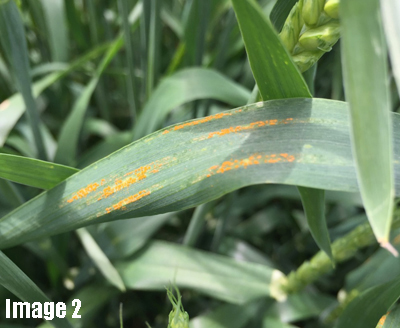
- Foliar diseases cause the most yield loss when symptoms reach the flag leaf.
- If foliar disease develops early and conditions favor development of disease, a fungicide application may be warranted, in addition to the head scab application at flowering.
- The common foliar diseases of wheat include powdery mildew, rusts, and leaf blotch complex.
- Scout for foliar disease in wheat from jointing to flag leaf emergence (Feeke’s 4-9).
- Several fungicides will provide effective control of foliar disease in wheat.
Impact of Foliar Disease in Wheat. Foliar fungal diseases have the potential to cause significant yield loss in wheat, approaching 50% losses in the most severe cases. The objective of foliar disease management in wheat is to protect the upper leaves from damage. The flag leaf is a critically important photosynthetic contributor, accounting for up to 70% of the carbohydrate production responsible for head fill. Typically, a triazole-based fungicide timed at flowering (Feeke’s 10.5.1) provides protection against both foliar diseases of the flag leaf and fusarium head blight. However, when foliar infection occurs early and conditions for further disease development are favorable, foliar disease can explode rapidly and threaten the upper leaves. When foliar infection threatens the flag leaf well before flowering, an additional fungicide application may be warranted. The critical period for scouting runs from the start of jointing (Feeke’s 4) to the emergence of the flag leaf (Feeke’s 9). In this article, we will briefly address a few of the most common and impactful fungal pathogens of wheat foliage.
Powdery Mildew is the most common foliar pathogen of wheat in the Midwest. It is characterized by powdery white to gray fungal growth, starting on the lower leaves early in the season and progressing up the plant (See Image 1). The pathogen overwinters locally in wheat residue or living plants, and often infects the plants in the fall shortly after planting. Development is favored by mild temperatures during April and May (59° to 72° F), high relative humidity (>85%), and dense stands.

Stripe (Yellow) Rust is caused by Puccinia striiformis and appears as small yellowish-orange pustules arranged in linear rows parallel to the veins (see Image 2). Lesions produce dusty orange spores that can freely move in the wind or on clothing to spread the infection. Field ‘hot spots’ up to 30-feet in diameter may be visible from a distance. Disease development is favored by humid weather and cool temperatures (50° to 60°F). The disease is inhibited by temperatures greater than 68°F at night or consecutive days above 80°F. Stripe rust requires a living host to survive the winter and typically migrates from the south, but it also thrives in the cool temperatures across the Midwest in early spring. The pathogen frequently evolves new races to outmaneuver resistant varieties.
Leaf Blotch Complex (Septoria, Stagonospora, Tan Spot). Septoria leaf blotch is among the most impactful of wheat diseases. It first appears as tiny yellow flecks on lower leaves, and expands to long angular brown lesions with yellow halos and regularly spaced tiny black dots, called pycnidia (see Image 3). Septoria prefers cool to moderate temperatures between 50° and 68°F and thus first appears in earlier growth stages. Stagonospora produces lens-shaped, tan-brown lesions with a regular border and yellow halo and light brown pycnidia only visible with a hand lens. Tan spot closely resembles Stagonospora, but lesions are discrete, more numerous, and lack pycnidia. Both Stagonospora and tan spot thrive in warmer temperatures between 68° and 81°F and thus appear later in the crop. All of these pathogens overwinter locally and distribute regionally as spores via wind and rain. Co-infections are possible on the same leaf.

Management Recommendations
- Apply principles of integrated pest management: scout, check weather forecasts, apply decision thresholds, and use a combination of cultural and chemical control practices.
- Incorporate wheat residues and control volunteer wheat to eliminate habitat bridges.
- Use crop rotation and take special precautions when wheat follows wheat or corn.
- Plant the highest yielding resistant varieties, when available.
- Manage plant stress and maintain good soil fertility and pH.
- Plant after fly-free dates in the fall to discourage fall infections.
- Apply fungicides at or before flag leaf emergence, based on confirmed presence of disease and forecasted favorable weather. Fungicides are most effective when used preventively.
- Consult the NCERA publication Fungicide Efficacy for Control of Wheat Diseases for which products are most effective on the diseases that are present.
- Caution: Products containing strobilurins should NOT be applied after flag leaf emergence, due to increased risk for vomitoxin formation.
Image 1. Powdery mildew in wheat.(Source: GROWMARK)
Image 2. Stripe rust in wheat. (Source: GROWMARK)
Image 3. Septoria leaf spot in wheat. (Source: GROWMARK)
References
Managing Wheat by Growth Stages (Purdue University)
Disease Management of Wheat (University of Kentucky)
Fungicide Efficacy for Control of Wheat Diseases (NCERA-184)